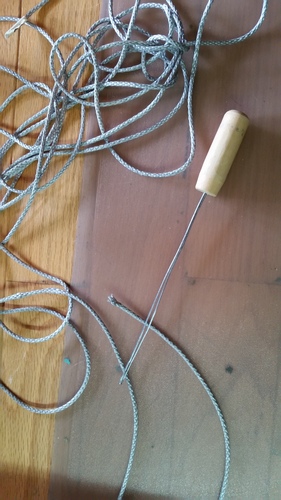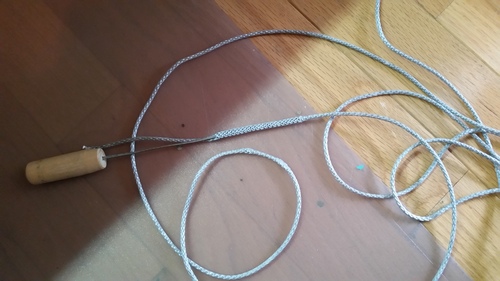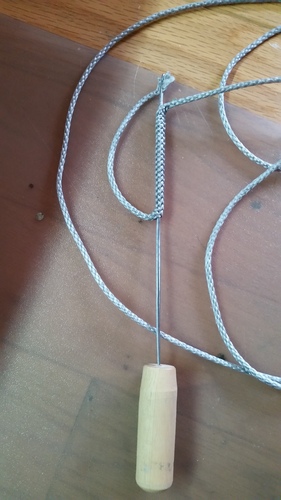Page 2 of 2
Re: 2 questions

Posted:
Mon Jul 11, 2016 9:41 amby jsbowman6
Talbot, the RONSTAN SERIES 40 AP double block only can be rotated to 2 positions by taking the stem pin out and moving it, that's one reason I added a SS chain link in the mix, but may try something with more flexibility. I'm thinking of taking the blocks stem pin out and seeing if the corners got rounded off if the block would simple rotate. I took the boat out yesterday and the halyards stayed put, that main is still hard to pull up. I need to drop the mast and look at what's going on. A lot of the friction is in the goose neck on the boom, it seems to bind in the sail slot, the other issue is when the main is 3 to 5 inches from the top, I think the splice is entering into the pulley and with that part being stiff, the main binds.
So here's a question that comes to mind: how high should the boom be relative to the cabin roof or sail slug entry slot? I may be trying to get the sail too high.
Carl, I've used a dry silicone spray in my sail slot and even squirted each slug as I put it into the slot. It helped a little. Not certain what you mean by "How is the line that supports the end of the mast set up?". If you mean the forestay, it's about 2/3's riveted with a strap to the mast and has a quick disconnect lever thing on the bow.
If I had not had an O'day 22 that was very easy to hand pull the mainsail up and cleat off the halyard, I guess I would just accept how hard the main is to deal with on this one. But I've made it better, just gotta figure out the details. Another thing I need to look at are the pulley sheaves, I replaced them with DR Marine ones and the ones they sent did not have a 1/4" bushing in them like the originals. (I'm still wondering if this mast is original).
Re: 2 questions

Posted:
Mon Jul 11, 2016 12:59 pmby talbot
To rig a topping lift:
1. Put a small cheek block as high as possible on the mast, either side.
2. Put a line through the block, at least 2x the height of the mast above the deck. With modern synthetics, the line could be quite small, but I use 3/16" Sta-Set polyester.
3. Put a shackle on the aft end of the line and fasten it to the boom end. (If you don't have a free hole in the end cap fitting, you can thread a loop of line through the hole that takes the outhaul shackle.)
4. Belay the forward end of the line to a cleat on the deck or the mast. Mounting to the mast is simpler. As Greenlake pointed out in a recent post on halyard organization, mounting mast cleats a couple of feet above the deck will minimize snagging jib sheets during tacks.
The topping lift is "lazy" while under way. It flops around the leech of the sail, or you can take it off the boom and fasten both ends to the cleat. If you leave the TL in place, have it slack enough that it does not interfere with the shape of leech. The TL is tensioned:
-- When raising or lowering the main sail to keep the end of the boom out of the cockpit.
-- At anchor or dock for the same reason, and to support cockpit covers or boom tents.
-- When reefing to create slack at the clew of the sail. This allows you to reef without dropping sail or stopping the boat, and may avoid unnecessary stretching of the sail during the operation.
-- In conjunction with the main sheet when tuning the mast. With the topping lift in place, pulling on the main sheet will bend the mast aft, allowing you to adjust the shroud turnbuckles.
Warning: The topping lift has enourmous leverage, 10' out at the end of the boom. If you are on the deck hauling the boom up with the lift, make sure the vang is slack. I actually broke a metal shackle on a vang once just trying to set up a boom tent.
Re: 2 questions

Posted:
Mon Jul 11, 2016 1:17 pmby talbot
Looks like I replied to carl10579 before the reply to my reply to . . . . um, anyway . . .
The answer to the boom question is: 24 inches. That is the specified height to the top of the boom above the top of the deck measured at the front of the mast. See
https://daysailer.org/Resources/Documents/dsbylaw3.pdfRegarding swivel shackles: In tight places where stainless shackles won't fit, I have begun using tied loops of Dyneema (Amsteel Blue). The only caveat is that the slippery fibers to not hold knots well. I use an overhand follow-through knot, the same as used for webbing slings in climbing. I've considered sewing the ends down, but I have not had one untie itself yet.
Re: 2 questions

Posted:
Sat Jul 16, 2016 9:19 amby jsbowman6
Well, I changed the SS chain link repair shackle for a soft shackle made from Amsteel to give the block more flexibility. Making it was surprisingly simple. Talbot mentioned it to me, so I watched a few youtube video's, took a piece of heavy gauge wire (electric fence) and bent it in half to make a fid. Splicing the eye was a very simple task compared to double braid.
Comments?
Re: 2 questions

Posted:
Sat Jul 16, 2016 1:06 pmby talbot
Slick. Especially the home made fid. I think you earned your merit badge.
Re: 2 questions

Posted:
Sat Jul 16, 2016 3:15 pmby GreenLake
Very nice! For anybody interested in doing some of their own splices, Amsteel is fun and easy to work with. It needs its own techniques, but they aren't complicated to follow or to get right. Soft shackles make a nice project for some non-sailing afternoon and are useful for all sorts of things.
Re: 2 questions

Posted:
Sat Jul 16, 2016 6:40 pmby jsbowman6
Since this is for a merit badge, here's some more pictures

Anyway as Greenlake said this Amsteel is a breeze to work with. It's real slick or slippery, so you have to do special knots, I haven't graduated to that yet, but there's a very nice design for like a soft shackle that you can take apart or kind of a soft carabiner.
https://www.youtube.com/watch?v=BFcxuNL37x8The thing I made was inspired by this video
https://www.youtube.com/watch?v=xcoKeXAwBZY. I only improve slightly on his fid design by adding a piece of dowel rod for a handle.

- The Splicer Fid
- 1 splicer.jpg (68.18 KiB) Viewed 10072 times

- Fid Inserted in Amsteel
- 2 splicer inserted.jpg (55.59 KiB) Viewed 10072 times

- Fid ready to pull Amsteel into itself
- 3 splicer ready to pull.jpg (55.34 KiB) Viewed 10072 times
Re: 2 questions

Posted:
Sat Jul 16, 2016 6:42 pmby jsbowman6
Here's a picture of the fid done with the pull.

- Fid done with pull
- 4 splicer done.jpg (49.29 KiB) Viewed 10072 times
Re: 2 questions

Posted:
Sun Jul 17, 2016 12:29 amby GreenLake
Very nice. Useful instructions and suggestions for doing projects with Amsteel are also found on
http://L-36.com.
(I'm moving this thread to "Rigging", as the discussion seems to be centered on how to set up running rigging and little of it is DSII-specific)
Re: 2 questions

Posted:
Wed Jul 20, 2016 9:34 amby jsbowman6
Continuing with the rigging theme and Amsteel Blue or Dyneema line splicing, I needed a carabiner that I could open and close and be strong. I found these video's
https://www.youtube.com/watch?v=jH66tGsWv_Y&feature=youtu.be and
https://www.youtube.com/watch?v=2bwKJIhSLEs. The one I made is about 3 1/2" long and takes 3 feet of the Amsteel Blue line! It only took a few minutes to splice, the hardest part to follow was making the knot at the end, but if you have the rope in hand and follow along with the first video, you can "cookbook" it. The video feels it can hold 800#'s, more than enough for my purpose, but your milage may vary. Here's a step by step for that pesky stopper knot
http://l-36.com/diamond_knot.php.
Re: 2 questions

Posted:
Wed Jul 20, 2016 10:56 amby GreenLake
Soft shackles are a neat thing. They are light and if used in places like the clew of the jib, can't damage anything by flailing. Their strength should be on the order of the full strength of the rope they are made from.. The reason is that the splice doubles the fibers and, of course, a shackle has tow parallel strand where the rope has only one.
On boats like the DS, the typical loads are so "light" that we almost always overdimension ropes. The limiting factor tends to be handling, not strength.